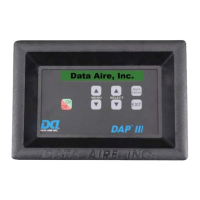8
DATA ALARM PROCESSOR – III
The Data Alarm Processor-III (DAP-III) offers the defi nite answer for precision environmental control. The DAP-III
control system not only controls and monitors temperature, humidity, airfl ow and cleanliness, it provides component run
times, alarm history and an automatic self-test of the microprocessor. All messages are presented in a clear simple
English and sequentially displayed on a backlit, liquid crystal display (LCD). The DAP-III can interface with a variety of
building management systems (BMS).
STANDARD FEATURES
Stand Alone Panel – Service terminals or additional devices are not required for programming or monitoring functions.
Microprocessor Based – State-of-the-art technology and reliability in a programmable solid-state control panel.
Smooth Keyboard Type Switches – High reliability, fl at, sealed switches with tactile feedback.
Two Row, 80 Character, Backlit Supertwist Liquid Crystal Display (LCD) – information is displayed and presented
in a format that is easily viewed and understood.
All Settings are Programmable from the face of the Panel – Expedient and user-friendly.
Layered Forward and Backward Menu Access – Facilitates programming with fl exible operation.
Multi-level Password Access– Controls any unauthorized changes to settings and system functions.
Database of Unit and Room Conditions – Historical data that facilitates service, apparatus setup and fi ne tuning of
setpoints.
Battery Backup for Historical Data – Extensive historical data is preserved by integral battery backup in case of power
failure.
Menus Factory Programmed – Menus that pertain to the type and method of cooling, reheat and humidifi cation based
on the unit’s components and options.
Programmed Settings Saved in Flash Memmory – Non-volatile memory stored so all control settings and operational
parameters are secured indefi nitely even during power outage.
Factory Calibrated Temperature and Humidity Sensors – Accurate and consistent regulation especially in multiple
unit applications.
Automatic Self-Test Diagnostics – Verifi es the processor and selected components are functioning properly at power
on and continuously during operation.
OPERATIONAL FEATURES
(Optional feature may require additional components and/or sensors.)
Sequential Load Activation – Time and temperature based logic that sequentially starts and stops stages of cooling
and reheat.
Compressor Short Cycle Control – Prevents excessive compressor wear by using restart and anti-cycle limits.
Automatic or Manual Restart – Restart methods are programmable in the event of a power failure.

